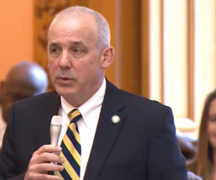BY SUSAN TEBBEN
With Gov. Mike DeWine spending the day before a holiday poring over a 1,200-page document debating line-item vetos, he had a lot of input from advocacy groups as to the final education budget.
A conference committee of Ohio House and Senate leaders reached an agreement last week, and on the last day of the month, the original deadline for passage of the budget, sent the document on to DeWine with a three-day extension.
Before it even hit the governor’s desk late Sunday night, education groups and some members of the Ohio State Board of Education had already sent messages urging vetos and explaining their lack of support for some parts of the education budget.
EdChoice vouchers
Ohio’s biggest teacher’s unions, the Ohio Federation of Teachers and the Ohio Education Association, joined with the Ohio Organizing Collaborative and think-tank Policy Matters Ohio to praise an increase in state funding that landed in the final budget via the Ohio House’s version, but also to express concerns about the private school vouchers expansion.
The groups, all part of a coalition called “All in for Ohio Kids,” called the nearly $1 billion increase in public school funding as part of a phase-in of the Fair School Funding Plan “a monumental step forward,” considering multiple rulings in DeRolph v. Ohio, in which the state’s highest court said the public education system in Ohio was unconstitutional.
“After decades of non-compliance with the Ohio Supreme Court rulings, the legislature is on the brink of finally meeting its constitutional responsibility to fairly fund Ohio’s public schools,” the coalition said in a joint statement.
The funding increases, which also included current data accounting for real-time costs of education disabled students and those for whom English is not their native language, unfortunately don’t distract from the “serious concerns” the coalition said it had about private school vouchers.
The compromise budget included near-universal private school scholarship eligibility, in which households earning up to 450% of the federal poverty level, or $135,000 for a family of four, qualifies for a full scholarship.
The scholarships amount to $6,165 for K to 8 students and $8,407 for high schoolers.
But the financial help doesn’t stop there, even for those families making more than $135,000 annually.
“Scholarships for students in families within incomes above 450% will be means-tested with scholarship amounts adjusted based on their income,” Senate President Matt Huffman’s office said in announcing the new budget. “Every student in Ohio will be eligible for a scholarship worth at least 10% of the maximum scholarship regardless of income.”
House Majority leadership said the program “is designed to safeguard lower-income families and offers options beyond traditional public schools,” according to a statement.
But the teacher’s unions and advocacy groups see the voucher “scheme” as a way to “ensure that state support for our public schools will be diminished to pay for tuition for private school students, no matter how wealthy their family is or how their school performs.”
“Priority should be given to fully implementing the Fair School Funding Plan so that our public schools, where 90 percent of students attend school, receive the resources they need instead of expanding unaccountable private school vouchers,” the coalition stated.
Preschool and child care
Even before K-12 education comes into play, the child welfare advocates at Groundwork Ohio say more could have been done within the budget to promote child care and preschool.
The group praised the restoration of $47 million the Senate version of the budget had removed in child care/preschool allocations, but pointed to the end of one-time COVID-era federal funding as a “massive cliff” that won’t be accounted for in the new budget.
The fact that the new funding won’t allow the publicly funded child care in the state to serve new children could result in the state “continuing to trail behind the rest of the nation as we only will now offer public support to a family of three making at or below $16.05 per hour when the average cost of infant care is well over $11,000 per year across the state,” according to a Groundwork budget analysis.
“The stark reality is that Ohio’s child care system is no more stable with this budget today than yesterday, despite years of parents, professionals and community leaders sounding the alarm – and the problem only gets worse,” the group said in a statement.
One element of education that did see improvement was the school lunch program. Nutrition advocates are relieved that the conference committee discussions ended in the restoration of expanded school lunch programs, something that was removed by the Senate in the previous budget draft.
The new state budget, barring any unexpected changes from DeWine, will include reimbursements for school districts so that any child eligible for the free or reduced-lunch program can receive breakfast and lunch at no cost, as long as the school participates in the National School Breakfast or Lunch Program.
“Ohio should be incredible proud of this step to expand access to free breakfast and lunch for our students, which will directly support working families and which acknowledges that adequate nutrition is an essential part of every child’s ability to learn, grow and fulfill their potential,” said Lisa Hamler-Fugitt, executive director of the Ohio Association of Foodbanks, in a statement.
SB 1
It wasn’t just advocacy groups speaking out against the inclusion of language previously a part of Senate Bill 1, which splits the Ohio Department of Education into the Ohio Department of Education and Workforce, puts the department under the authority of the governor’s office, and limits the State Board of Education.
Seven of the members of the board wrote a letter to DeWine the day he received the budget asking for him to veto the voucher expansion, along with the “power grab” of changing the the state board’s roles.
“The budget moves educational governance from a primarily elected body, the State Board of Education, to an appointed director who answers to the governor and the legislature,” states the letter from board members Christina Collins, Teresa Fedor, Katie Hofman, Tom Jackson, Meryl Johnson, Michelle Newman and Antoinette Miranda.
Under the senate bill now included in the budget, the board authority would now be mainly limited to teacher disciplinary and licensure cases and territory disputes.
According to the Legislative Service Commission, creating a new director position for the ODEW “may increase annual costs by up to $254,000,” and creating two deputy director position, one for education and another for workforce, could up costs from $151,000 to $189,000 for each position.
Appropriation for the state board would be $14.4 million in fiscal year 2024 and $14.7 million in the next fiscal year, which would be in a “standalone budget” strictly for the board.





